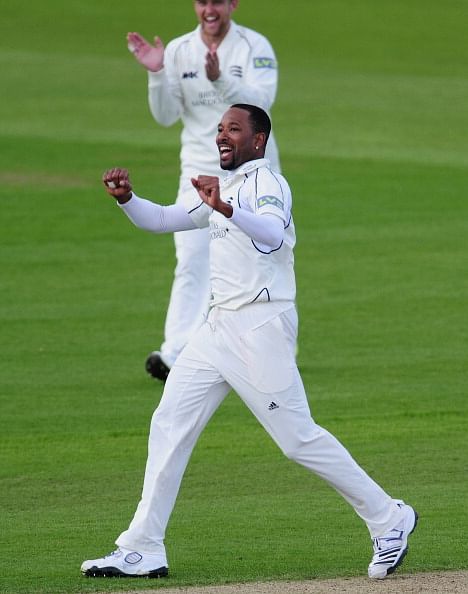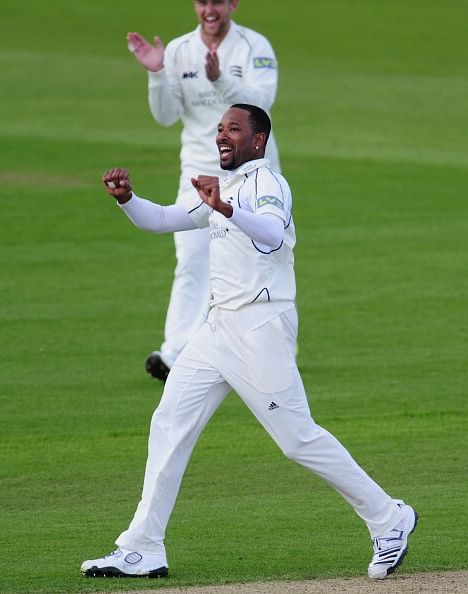
The terminal decline of West Indies's pace bowling battery - Part 2
(Here is the first part of the article)
Corey Collymore, by surprising the famed Australian batting line-up with lively pace at Antigua in 98/99, showed flashes of his brilliance. However, in the case of Collymore, just when it seemed like the Windies had found a gem of a quick bowler, tragedy struck, as he was laid low by a stress fracture on his back. With perseverance and dogged determination, he resurrected his career. In his second coming in international cricket, it was crystal clear that he had lost the zip in his bowling, and was nothing more than an honest trier. He did add another string to his bow by refining his skills to move the ball in the air which helped him to be reasonably successful at the Test level. Interestingly, the utilitarian still plies his trade in the county-circuit.

Corey Collymore
In that same series against Australia in 98/99, Fiedel Edwards’s half brother, Pedro Collins, too made his Test debut. Pace wasn’t his forte, but Collins brought the much needed variety into the attack, as he was a left armer, and swung the new ball, as well as the old ball, prodigiously. A case in point being his 6-for against Kiwis at Jamaica in 01/02 when he swung the old ball. The problem with Collins was that he was a one-dimensional cricketer. He couldn’t bat, and to make it worse, as a fielder he seemed to have iron-hands.
On a batting paradise at Georgetown, Guyanese Reon King took a slightly weary Indian touring side by surprise, with his uncanny ability to get awkward bounce from the surface, in a warm-up game in 96/97. King took a 7-for in the first innings of that match. He made his Test debut during the ill-fated tour to the rainbow nation in 98/99. But it was when Zimbabwe and Pakistan toured the Caribbean in 99/00 that he showed his wares by taking crucial wickets.
There was an inkling that King would become the lynchpin of West Indies’s attack in years to come. Sadly, King lost his rhythm, and his confidence was shattered in England in 2000 as he bowled a plethora of full-tosses. King did make a comeback to the side in 04/05 when a raft of senior players went on strike, but by then he was nothing more than a journeyman medium-pacer.
The burly Marlon Black came into prominence when he took 4 for 83 in muggy conditions at Gabba against ‘the ‘Invincibles’, Australia, in 2000/01. It was also a tour where Black was assaulted very badly on his head, while returning from a night club, by a bunch of drunken muggers. He never seemed to recover fully from that assault. At just 29, when a quick bowler usually finds himself at the peak of his prowess, he gave up on cricket.
In that same series in Australia, Colin Stuart, too, made his presence felt. Short in stature but with a bustling run-up, he was a slippery customer. In spite of not taking too many wickets Down Under, he did bowl some incisive spells against the marauding Australians. It still remains a mystery as to where he vanished after playing a Test series against Sri Lanka the following year. Yes, he did play a handful of first-class games for Guyana until 02/03, but no one knows why he left the scene at the age of just 30. In short, he disappeared into thin air.
The Jamaican, Jermaine Lawson, made the entire cricketing world take notice of his fast bowling prowess when he bowled with fire and brimstone to burst through the much-vaunted Indian batting line-up in an ODI match in 02/03. He seemed to be the real deal, as he could consistently bowl 90mph thunderbolts with decent control too. He also left an indelible mark on batsmen of repute from Australia the following year, by taking a 5-for at the fast bowler’s graveyard – Antigua. But stress fractures and questions being raised about the legality of his ragged action didn’t help his cause. Haphazard selection policies didn’t make it easy for him either. Lawson’s career was a case of what might have been.
When the towering giant, Ryan Nurse, played in the under-19 WC in 01/02, it seemed like he was a giant surrounded a band of dwarfs. The towering giant was known to be a bowler who could extract disconcerting bounce from a track. However, in first class cricket, his performances weren’t exactly earth-shattering. At the age of just 25, he vanished completely from the scene.
The bright prospect from Jamaica, Dwight Washington, was another of those who was built like an edifice. He made his Test debut at the age of just 21 against South Africa at Antigua in 04/05. At the age of 22 though, he dropped out of professional cricket. As per West Indies’s cricket cognoscenti, he left for the US in search of greener pastures.